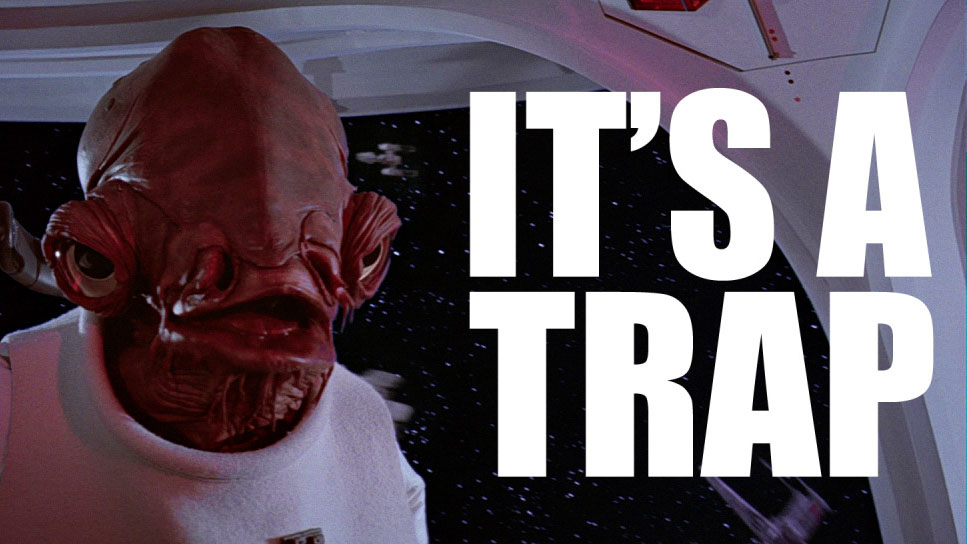Welcome back to the Season 4 Bootcamp! It’s time to start about one
of the things that can leave your models stranded and potentially
invalidate a lot of your influence. Time to talk about traps.
So, let us dive in.
That’s it for today! Next time, we will look at the defensive options of Counterattacks and Defensive Stance.
What are traps in Guild Ball?
I am not alking about the trap markers that the Hunter’s Guild can put out here. These traps are abilites on models that can get you into a lot of trouble or just end your activation without you spending all your influence. Since you can’t bank any influence, not getting to spend all of it is suboptimal or sometimes catastrophic.So, let us dive in.
Unpredictable Movement(UM)
A model with unpredicable Movement can dodge 2″ if you enter the melee zone with an advance. Most models with this rule only have a 1″ Melee Zone, but Greyscales, Naja and Obulus feature a 2″ Melee zone.If you run into it unprepared, it can leave the opposing model out of your melee zone and your model is unable to attack anyone. Also note that this rule still works when the model is knocked down. It still has a melee zone(albeit not engaging anyone) and it still can make dodges.How do I counter it?
There are several ways to get around Unpredictable Movement. Since it only triggers on an advance, you can dodge into the opposing melee zone without triggering it. The best way is using a 2″ Melee model to either stay out of 1″ of the opponent, or in the case of a 2″ UM model, you can go base-to-base and if he dodges away, you can still hit them. You can also try to push the opponent into your melee zones and then you can start wailing on them without needin to advance towards them.Counter Charge(CC)
This rule is not always called Counter Charge and is often Conditional (Rush Keeper on Compound or Fork Off on Tater), but it does the same thing. If an enemy advances into 6″, you it can immediately get charged. This can result in pushes or other nasty stuff that messes with you, the “best case” is that ou will suffer a crowdout.Countering Counter Charge?
You can always try to engage a CC Model, since a model that is engaged can’t declare a charge. In fact, if you advance in a way that the Countercharger engages you, he can’t declare a charge either. Dodging in does work, too, as does pushing the CC-Model in a way that the condition isn’t met. Sometimes, you might need to just stay out of 6″ of the model altogether.The disengaging Counterattack
This one can be a bit more complex. A Counterattack with any double-Reposition(Double Dodges, Double Pushes, Push-Dodges) can put 2″ between the attacker and the counter-attacker. Sometimes, A Knockdown can also end an activation (If the active model already advanced and used Rest).Thwarting the Counter-Attack
The easiest counter is to just knock the counterattacking model down. If he can’t counterattack, he can’t hit any Repositions. A 2″ Melee model can also go base-to-base so that a double reposition won’t get the enemy out of melee. There are some triple-Repositions around, but high in the playbook, but you should still keep an eye out for them. If you can attack before the advance, the counter will also do next to nothing. Sometimes, you just need to make a Risk-reward assesement and take the risk of the opponent’s counterattack.Resilience and Sturdy
Resilience(ex. Mash) and Sturdy(ex. Hearth) are two rules that makes it easier to get to make counter attacks. A model with Resilience is 100% guaranteed to counter you if you attack it and Resilience is up, and Sturdy ignores the most common counter to counterattacksSo what do I do now?
Thankfully, both these abilites only work on the first time a model is hit. Resilience can be broken by using a ranged character play like Marked Target from Boiler, and Sturdy can be broken by any Knockdown. A model with just one Influence can also just roll an attack on a model with Resilience or Sturdy and doesn’t care much for the counterattack. Additionally, the Counterattacks of these models are often not that great and you can look at the playbooks and make a decision if just tanking the counter is worth it.That’s it for today! Next time, we will look at the defensive options of Counterattacks and Defensive Stance.

No comments:
Post a Comment